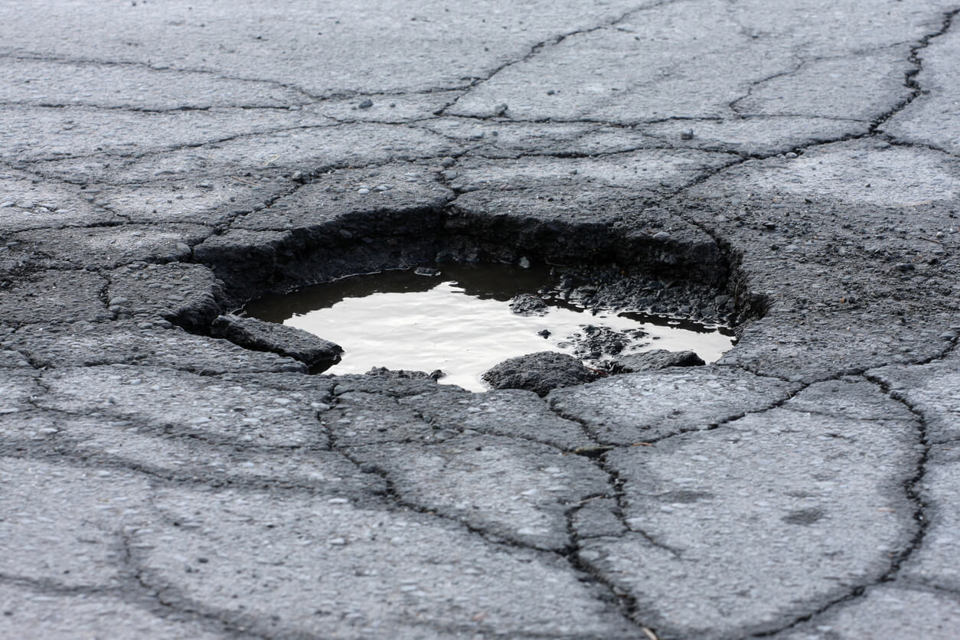Local authorities are filling a pothole every 17 seconds, but still paid out £6.9 million in pothole compensation claims, according to this year’s Annual Local Authority Road Maintenance (ALARM) survey.
It also reveals that the average time in England and Wales before a road is resurfaced is 67 years (79 years in England, 28 years in London and 59 years in Wales).
The report’s authors, the Asphalt Industry Alliance (AIA), says there are signs that an increase in local authority highway maintenance budgets is stemming the decline in the condition of the local road network, but the increased investment is still falling short of the amount needed to maintain local roads to target conditions.
For the second consecutive year, local authorities’ highway maintenance budgets have increased by almost 20%. For councils in England and London this included a share of £420m additional funding allocated in the November 2018 Budget.
The 24th ALARM report shows there are early signs that the extra money is halting further decline, after years of underfunding have led to a local road network on the edge. However, the one-time catch-up cost to fix the network continues to rise.
Rick Green, chairman of the AIA, said: “There are glimmers of hope but, while overall highway maintenance budgets are up, there is still a big discrepancy between the haves and have nots. Some local authorities received the equivalent of £90,000 per mile of their individual networks, while a third continue to struggle with reduced budgets, with several having less than £9,000 per mile to maintain their local roads.
“Achieving target conditions on all categories of local roads – those that we all rely on every day – still remains out of reach. To put this into context, if local authorities had enough funds to meet their own targets across all road types it would give us more than 20,000 miles of improved local roads.”
Green says it is encouraging that politicians have recognised the value that additional expenditure on roads can deliver, but is concerned that, from the 29% increase in the number of potholes filled in England and London, much of this has been used for patch and mend.
“This doesn’t provide value for money, nor will it improve the underlying structure and resilience of our roads,” he said.
“With the amount needed to bring the local road network up to scratch still approaching £10 billion, sustained investment over a longer timeframe is needed if we want a local road network that supports enhanced mobility, connectivity and productivity.”
Last year, the AIA set out that £1.5 billion additional funding was needed for local roads each year for the next 10 years to allow them to be brought up to a condition from which they can be managed in a cost-effective way.
“We stand by this call,” continued Green.
AA president Edmund King OBE believes that the survey’s findings suggest that the country is beginning to find its way “out of the rut”.
“Increased funding and a milder winter presents an opportunity to begin to catch up on the backlog – but any slackening off will simply pitch our roads back into a deep hole,” he said.
“Government figures for road maintenance expenditure show that, while spending on main roads has risen 25% over the past 10 years, it has fallen more than 21% on minor roads.
“At street level, as the ALARM survey shows, drivers will be lucky to see many of their local roads resurfaced more than once in their lifetime, thanks to an average interval of 67 years. There is still a lot of work to be done.”
Cllr Martin Tett, the Local Government Association’s transport spokesman, added: “Councils share the frustration of motorists about the state of our local roads and, as this survey shows, fixing our roads is a priority for them. Faced with severe financial pressures, councils have managed to spend more on road repairs in the past year in order to fix a pothole every 17 seconds.
“Despite these efforts, it is clear that our roads are deteriorating at a faster rate than can be repaired by councils, with the cost of clearing our alarming national roads repair backlog on the rise and now at almost £10bn.
“Extra one-off funding announced in the Budget will help councils continue to try and improve roads this year but the Spending Review needs to provide councils with long-term and consistent funding to invest in the resurfacing projects which our road network desperately needs over the next decade.”
Tett claims that reinvesting 2 pence per litre of existing fuel duty into local road maintenance would provide £1bn a year for councils to spend on improving roads and filling potholes and begin bringing our roads up to scratch.
RAC head of roads policy Nicholas Lyes concluded: “The results from this year’s survey chimes with our own breakdown data, which suggests the overall state of the UK’s roads is not getting any worse.
“But this is hardly positive – it remains the case that a driver today is still more than twice as likely to breakdown as a result of a pothole than in 2006, and potholes not only cause expensive damage to vehicles but are also a very real road safety danger for drivers, bikers and cyclists alike.
“Surely it shouldn’t be the case in 2019 that a driver can switch from a major A-road to a minor road and see an immediate degradation in surface quality.”
He also believes the Government should ring-fence existing funds raised from fuel duty in addition to what is already allocated to councils, and would go some way towards clearing the backlog of potholes that currently plague many parts of the UK.
The full ALARM survey is available to download from www.asphaltuk.org.























Login to comment
Comments
No comments have been made yet.